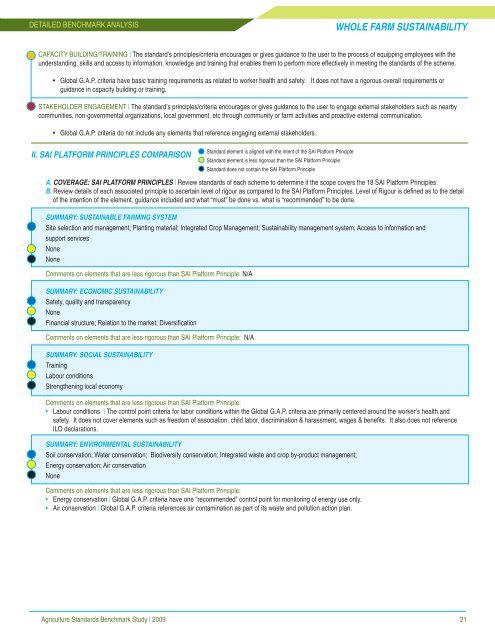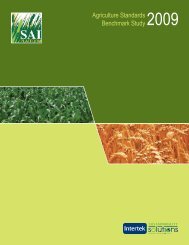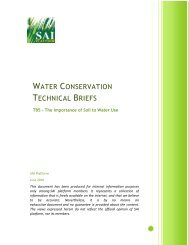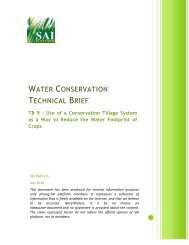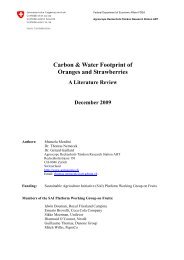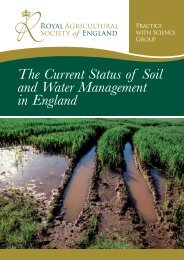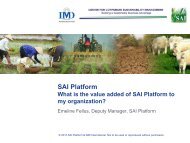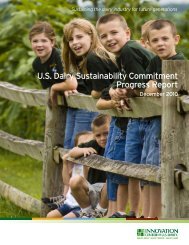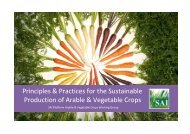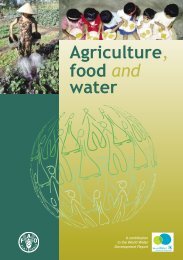DETAILED BENCHMARK ANALYSIS - SAI Platform
DETAILED BENCHMARK ANALYSIS - SAI Platform
DETAILED BENCHMARK ANALYSIS - SAI Platform
You also want an ePaper? Increase the reach of your titles
YUMPU automatically turns print PDFs into web optimized ePapers that Google loves.
<strong>DETAILED</strong> <strong>BENCHMARK</strong> <strong>ANALYSIS</strong><br />
WHOLE FARM SUSTAINABILITY<br />
CAPACITY BUILDING/TRAINING | The standard’s principles/criteria encourages or gives guidance to the user to the process of equipping employees with the<br />
understanding, skills and access to information, knowledge and training that enables them to perform more effectively in meeting the standards of the scheme.<br />
• Global G.A.P. criteria have basic training requirements as related to worker health and safety. It does not have a rigorous overall requirements or<br />
guidance in capacity building or training.<br />
STAKEHOLDER ENGAGEMENT | The standard’s principles/criteria encourages or gives guidance to the user to engage external stakeholders such as nearby<br />
communities, non-governmental organizations, local government, etc through community or farm activities and proactive external communication.<br />
• Global G.A.P. criteria do not include any elements that reference engaging external stakeholders.<br />
II. <strong>SAI</strong> PLATFORM PRINCIPLES COMPARISON<br />
Standard element is aligned with the intent of the <strong>SAI</strong> <strong>Platform</strong> Principle<br />
Standard element is less rigorous than the <strong>SAI</strong> <strong>Platform</strong> Principle<br />
Standard does not contain the <strong>SAI</strong> <strong>Platform</strong> Principle<br />
A. COVERAGE: <strong>SAI</strong> PLATFORM PRINCIPLES | Review standards of each scheme to determine if the scope covers the 18 <strong>SAI</strong> <strong>Platform</strong> Principles<br />
B. Review details of each associated principle to ascertain level of rigour as compared to the <strong>SAI</strong> <strong>Platform</strong> Principles. Level of Rigour is defined as to the detail<br />
of the intention of the element, guidance included and what “must” be done vs. what is “recommended” to be done.<br />
SUMMARY: SUSTAINABLE FARMING SYSTEM<br />
Site selection and management; Planting material; Integrated Crop Management; Sustainability management system; Access to information and<br />
support services<br />
None<br />
None<br />
Comments on elements that are less rigorous than <strong>SAI</strong> <strong>Platform</strong> Principle: N/A<br />
SUMMARY: ECONOMIC SUSTAINABILITY<br />
Safety, quality and transparency<br />
None<br />
Financial structure; Relation to the market; Diversification<br />
Comments on elements that are less rigorous than <strong>SAI</strong> <strong>Platform</strong> Principle: N/A<br />
SUMMARY: SOCIAL SUSTAINABILITY<br />
Training<br />
Labour conditions<br />
Strengthening local economy<br />
Comments on elements that are less rigorous than <strong>SAI</strong> <strong>Platform</strong> Principle:<br />
• Labour conditions | The control point criteria for labor conditions within the Global G.A.P. criteria are primarily centered around the worker’s health and<br />
safety. It does not cover elements such as freedom of association, child labor, discrimination & harassment, wages & benefits. It also does not reference<br />
ILO declarations.<br />
SUMMARY: ENVIRONMENTAL SUSTAINABILITY<br />
Soil conservation; Water conservation; Biodiversity conservation; Integrated waste and crop by-product management;<br />
Energy conservation; Air conservation<br />
None<br />
Comments on elements that are less rigorous than <strong>SAI</strong> <strong>Platform</strong> Principle:<br />
• Energy conservation | Global G.A.P. criteria have one “recommended” control point for monitoring of energy use only.<br />
• Air conservation | Global G.A.P. criteria references air contamination as part of its waste and pollution action plan.<br />
Agriculture Standards Benchmark Study | 2009<br />
21


